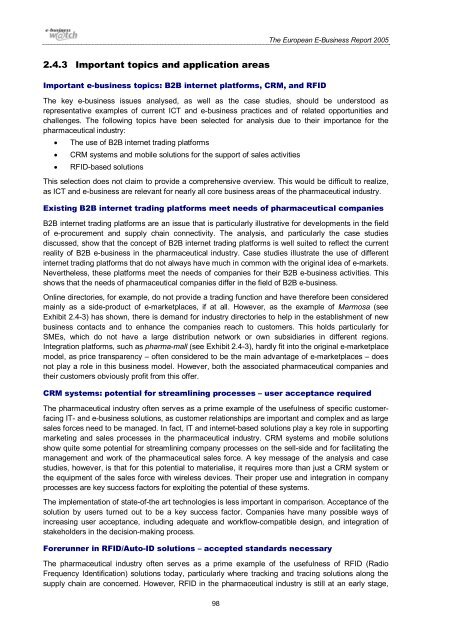The European e-Business Report The European e ... - empirica
The European e-Business Report The European e ... - empirica
The European e-Business Report The European e ... - empirica
Create successful ePaper yourself
Turn your PDF publications into a flip-book with our unique Google optimized e-Paper software.
<strong>The</strong> <strong>European</strong> E-<strong>Business</strong> <strong>Report</strong> 2005<br />
2.4.3 Important topics and application areas<br />
Important e-business topics: B2B internet platforms, CRM, and RFID<br />
<strong>The</strong> key e-business issues analysed, as well as the case studies, should be understood as<br />
representative examples of current ICT and e-business practices and of related opportunities and<br />
challenges. <strong>The</strong> following topics have been selected for analysis due to their importance for the<br />
pharmaceutical industry:<br />
• <strong>The</strong> use of B2B internet trading platforms<br />
• CRM systems and mobile solutions for the support of sales activities<br />
• RFID-based solutions<br />
This selection does not claim to provide a comprehensive overview. This would be difficult to realize,<br />
as ICT and e-business are relevant for nearly all core business areas of the pharmaceutical industry.<br />
Existing B2B internet trading platforms meet needs of pharmaceutical companies<br />
B2B internet trading platforms are an issue that is particularly illustrative for developments in the field<br />
of e-procurement and supply chain connectivity. <strong>The</strong> analysis, and particularly the case studies<br />
discussed, show that the concept of B2B internet trading platforms is well suited to reflect the current<br />
reality of B2B e-business in the pharmaceutical industry. Case studies illustrate the use of different<br />
internet trading platforms that do not always have much in common with the original idea of e-markets.<br />
Nevertheless, these platforms meet the needs of companies for their B2B e-business activities. This<br />
shows that the needs of pharmaceutical companies differ in the field of B2B e-business.<br />
Online directories, for example, do not provide a trading function and have therefore been considered<br />
mainly as a side-product of e-marketplaces, if at all. However, as the example of Marmosa (see<br />
Exhibit 2.4-3) has shown, there is demand for industry directories to help in the establishment of new<br />
business contacts and to enhance the companies reach to customers. This holds particularly for<br />
SMEs, which do not have a large distribution network or own subsidiaries in different regions.<br />
Integration platforms, such as pharma-mall (see Exhibit 2.4-3), hardly fit into the original e-marketplace<br />
model, as price transparency – often considered to be the main advantage of e-marketplaces – does<br />
not play a role in this business model. However, both the associated pharmaceutical companies and<br />
their customers obviously profit from this offer.<br />
CRM systems: potential for streamlining processes – user acceptance required<br />
<strong>The</strong> pharmaceutical industry often serves as a prime example of the usefulness of specific customerfacing<br />
IT- and e-business solutions, as customer relationships are important and complex and as large<br />
sales forces need to be managed. In fact, IT and internet-based solutions play a key role in supporting<br />
marketing and sales processes in the pharmaceutical industry. CRM systems and mobile solutions<br />
show quite some potential for streamlining company processes on the sell-side and for facilitating the<br />
management and work of the pharmaceutical sales force. A key message of the analysis and case<br />
studies, however, is that for this potential to materialise, it requires more than just a CRM system or<br />
the equipment of the sales force with wireless devices. <strong>The</strong>ir proper use and integration in company<br />
processes are key success factors for exploiting the potential of these systems.<br />
<strong>The</strong> implementation of state-of-the art technologies is less important in comparison. Acceptance of the<br />
solution by users turned out to be a key success factor. Companies have many possible ways of<br />
increasing user acceptance, including adequate and workflow-compatible design, and integration of<br />
stakeholders in the decision-making process.<br />
Forerunner in RFID/Auto-ID solutions – accepted standards necessary<br />
<strong>The</strong> pharmaceutical industry often serves as a prime example of the usefulness of RFID (Radio<br />
Frequency Identification) solutions today, particularly where tracking and tracing solutions along the<br />
supply chain are concerned. However, RFID in the pharmaceutical industry is still at an early stage,<br />
98

















